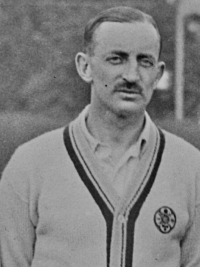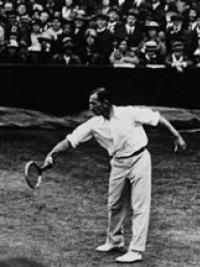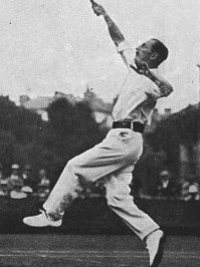Algernon Kingscote
Full name: Algernon Robert Fitzhardinge Kingscote
Nickname: Algie
Nickname: Algie
| Born | December 03, 1888 in Bangalore, Karnathka, India |
|---|---|
| Died | December 21, 1964 in Woking, Surrey, England, UK |
| Plays | Right-handed |
| Bio | Algernon Kingscote was born on December 3,1888 to Lieutenant-Colonel Howard Kingscote and famous novelist Adeline Wolff known as Lucas Cleeve. He had two siblings, Henry and Iris. He learned playing tennis on the courts of the Château-d'Œx Club in Switzerland, where he won numerous championships. In his early years he trained with American teenager player R. Norris Williams. He was crowned Swiss champion in 1908 and champion of Bengal in 1913. Like his father he joined the army in 1910 serving for the Royal Garrison Artillery. He was a Second Lieutenant when stationing at Plympton, Devon in 1911. He was engaged during in World War I where he fought at the First Battle of the Aisne earning the rank of Lieutenant-Colonel and the award of Military Cross. He held the Kent Championships title for four consecutive years between 1919–1922 and in total won the title seven times. He won the singles title at the 1919 Australasian Championships, along with the first Anthony Wilding Memorial Medal, beating Eric Pockley of New South Wales in straight sets. In the 1920 Wimbledon Championships he reached the doubles final alongside James Cecil Parke but eventually lost to the team of Garland-Williams. In 1921 Kingscote was a runner-up at the Monte-Carlo Championships losing to fellow countryman Gordon Lowe in four sets. He represented Great Britain in the Davis Cup seven times between 1919 and 1924 compiling a 9–8 win-loss record. In the 1922 Wimbledon Championships first round against Leslie Godfree they established the routine of saluting the Royal Box by bowing in front of it, a tradition that was in effect to 2003. He won the Queen's Club Championships in 1924 beating Gordon Lowe in four sets in the final and also competed in the 1924 Summer Olympics in Paris. U.S. Championships quarterfinalist American Dean Mathey described his style as "well rounded" in 1920 at the time when he was considered the best British outdoors player. He favored volleying and had good ground strokes. His service was fair but his game lacked speed and strength. The next year professional world number one player Bill Tilden agreed with Mathey that his game is well rounded but lacks speed. He described his hitting as well-paced, his service as a fast sliced, well placed, paced, twisted and cleverly disguised and his style as a defensive one relying mostly on his half-volley baseline returns. He dedicated Kingscote's court positioning and good volleying skills as a compensation for Kingscote's rather short appearance. Kingscote adapted to the combination of net attack and baseline game, which Tilden praised as a key factor of successful tennis style. His favorite shot was the cross court forehand shot.His backhand was steady, accurate and deceptive. After the war he went back competing in tennis tournaments and was appointed the captain of the Great Britain Davis Cup team, while still serving in the army as a colonel.He married Marjorie Paton Hindley and had two daughters Rachel and Marjorie and later a son David. At the age of 52 at the outbreak of World War II he was sent back to action again |
| Misc | According to William Tilden: "The most recent star to reach the heights of fame in English tennis is Major A. R. F. Kingscote. Kingscote has played good tennis for some years; but it was only in 1919, following his excellent work in the War, that he showed his true worth. He defeated Gobert in sequence sets in the Davis Cup tie at Deauville, and followed by defeating Anderson in Australia and carrying Patterson to a hard match. Since then he has steadily improved and this season found him the leading figure of the British team. Kingscote played much of his early tennis with R. N. Williams in Switzerland during 1910 and 1911. The effect of this training is easily seen on his game to-day for, without Williams' dash and extreme brilliancy, their strokes are executed in very much the same style. Kingscote's service is a fast slice, well placed and cleverly disguised. It carries a great deal of pace and twist. His ground strokes are hit off the rising bound of the ball, with a flat raquet face or a slight slice. His wonderful speed of foot offsets his lack of height, and he hits either side with equal facility. There are no gaps in Kingscote's game. It is perfectly rounded. His favourite forehand shot is 'cross court, yet he can hit equally well down the line. His backhand is steady, very accurate and deceptive, but rather lacks speed. His volleying is remarkable for his court covering and angles, but is not the decisive win of Williams or Johnston. He is the best volleyer in the British Isles. His overhead is reliable and accurate for so short a man, but at times is prone to lack speed. Kingscote is a sound tactician without the strategic brilliance of Parke. He is a fine match player and dogged fighter. Witness his 5-set battle with me in the Championships, after being match point down in the fourth set, and his 5-set struggle with Johnston in the Davis Cup. It is a slight lack of decisiveness all round that keeps Kingscote just a shade below the first flight. He is a very fine player, who may easily become a top-notch man. His pleasant, modest manner and generous sportsmanship make him an ideal opponent, and endear him to the gallery." |
| Tournament | AO | RG | W | US | Win-Loss |
|---|---|---|---|---|---|
| 1914 | A | A | R64 | A | 1-1 |
| 1915 | A | A | A | A | 0-0 |
| 1916 | A | A | A | A | 0-0 |
| 1917 | A | A | A | A | 0-0 |
| 1918 | A | A | A | A | 0-0 |
| 1919 | CH | A | F | A | 10-1 |
| 1920 | A | A | R16 | A | 2-1 |
| 1921 | A | A | QF | A | 4-1 |
| 1922 | A | A | R16 | A | 3-1 |
| 1923 | A | A | A | A | 0-0 |
| 1924 | A | A | QF | A | 4-1 |
| 1925 | A | A | A | A | 0-0 |
| 1926 | A | A | A | A | 0-0 |
| 1927 | A | A | R64 | A | 1-1 |
| Win-Loss | 4-0 | 0-0 | 21-7 | 0-0 | 25-7 |


